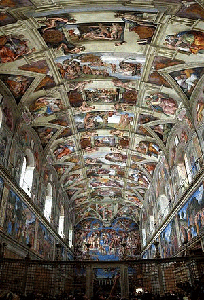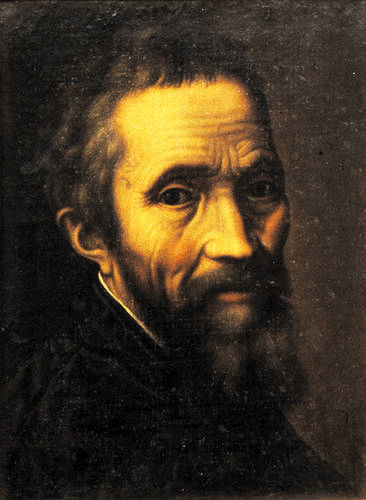What is a Frescoe
At the very outset allow me to define what a Fresco is.
A Fresco is a wall painting, where in paint is applied to the wall when the plaster is still wet. This is to enable the paint and the plaster blend thoroughly.The art of applying paint to the wet plaster is as old as antiquity. The very name Fresco conjures up a series of famous frescoes like the cave paintings in Ajanta caves to the frescoes of Sistine chapel in Rome. The cave paintings of Ajanta were painted by a guild of artists who worked for their patrons. Where as the frescoes Of Sistine chapel were the creation of one single painter, Michelangelo.
The technique.
Fresco painting is a tedious job that involves fast working as it is necessary to finish the work before the prepared plaster dries up.The work process involves applying water color on the surface of the plaster that was made beforehand. The artist cannot use a colour range of his own. He has to work with a limited colour range. Additionally, the limited colour range will become lighter when dried up. Owing to this reason, the painter should envisage his required colour effect beforehand and has to allow for this.
The artist has to draw a precise sketch. This sketch will be cut in to pieces and placed on the prepared ground. After this, and the outline is traced through on to the painting surface. This gives an idea to the artist about the edges. In other words, these outlines will act like guidelines drawn on a tracing paper. It also gives an idea about the quantum of work that's completed in a day.
After this, if an artist wants to make a correction or add something extra to the art work. he can do so by the method of Secco. Secco is works just in opposite way to fresco. That is like fresco the artist need not work on wet plaster but on the dried out plaster.
There is another limitation in Fresco painting especially in the high altitude works . An artist has to check from time to time whatever work he has done till then has come according to his plan or not. For this, he has to step back and see This can't be done on a job where scaffolding is erected for the workers who work on high altitudes.
Michelangelo who painted the frescoes of Sistine chapel, the most celebrated frescoes in the history of Art describes these conditions as " appalling " through a sonnet to Giovanni Pistoja. Historians say that Michelangelo's feat is unparalleled. He has not only taken all the physical inconvenience and pain in to his own stride, but he has done all the jobs starting from Conception to execution single Handed.
The Sistine Chapel
Sistine chapel is a brick structure. Its dimensions are 132 feet long and 44 feet wide. It'smaximum height is 68 feet. A shallow barrel- vault flattened at the top 1s there. In the year 1503, Michelangelo was called to Rome by Pope Julius II and commissioned to work on the shallow barrel vault of the Sistine Chapel. Michelangelo has to paint twelve Apostles.
A bit about Michelangelo
Michelangelo di Lodovico di Buonarroti was born on 6 March 1475 in the town of Caprese. Caprese is situated forty miles away from Florence. He wanted to become a sculptor of repute.
When he was called by Pope Julius II to Rome to build a tomb for himself with forty marble statues which are greater than life size, Michelangelo's joy touched the stars. Michelangelo took it as a great challenge and thought that there's is a chance for him to prove his mettle to the world. As luck would have it, suddenly Pope Julius lost interest in the tomb and in turn commissioned Michelangelo to paint the walls of Sistine Chapel
Michelangelo showed his discontentment because he was given a job in which, he has neither heart nor interest. But Pope Julius is a person who gets what he wants. Many efforts were made by Michelangelo to get away from the clutches of tyranny of Pope Julius II. Pope Julius II had the last laugh. Michelangelo had to start the work on Sistine chapel. And in January 1509 fresco painting work of Sistine chapel started.
Features unique only to Sistine Frescoes.
The frescoes of Sistine Chapel are not just another wall filling paintings. They are a fulfilled 'Art curriculum.' These frescoes contain all conceivable forms of humans, expressions, a multitude of compositions and arrangements and drapery.It's like an Art text book. A fantastic reference book at it.
Michelangelo's drawing and Draftsmanship in these frescoes are beyond words. Though the frescoes are painted on walls two dimensionally,they look like real life characters with the additional third dimension.
His colour mixing ability is clearly visible.The fact that these classic paintings didn' lose their colour is a testimony for Michelangelo's Colour knowledge.
All the frescoes of Sistine chapel are Narrative paintings. There need not be any commentary. All f them are self explanatory.
It's all about Creation.
Michelangelo's Frescoes adorning the walls of Sistine Chapel depict about the creation of man to his downfall. From the creation of Adam to the expulsion from the garden of Eden.In between the Hebrew prophets like Isaiah, Jeremiah, Zechariah to name a few and the five pagan Sibyls are included. Michelangelo has become successful in incorporating the Histories along the central flattened strip of the ceiling.
In all Sistine chapel's walls depicted nine scenes from the book of genesis.
The painting depicting the god saying, "let there be light." In this painting God is seen with raised hands. The care with which Michelangelo depicted the stance of the God makes an indelible mark on the viewer's heart. God's flowing robes area treat to the eye and speak volumes about the painting skills of Michelangelo.
Then comes the panel that depicts the creation of Sun and Moon. It's a two part fresco. On the right side God is seen as creating the Sun and Moon. His gestures and facial expressions indicate the supreme power of the omnipotent.
The panel of The creation of Adam is considered as Michelangelo's ultimate thoughts on complete beauty.
The other panels adorning the central ceiling of Sistine chapel are, the Creation of Eve,Fall and expulsion of Adam and Eve, the flood,The Ignudi are equally awe inspiring
Why they are compelling
Basically Michelangelo was a sculptor. He himself declared once that he was no painter. If that was the truth, the frescoes wouldn't have lasted for 500 years. nIts phenomenal success points out to only one reason.Michelangelo's supernatural artistic skills, dedication and grit. Behind this mammoth success, one should imagine the amount of agony he suffered.
He took four years to complete the mammoth job of frescoes that covered 460 square meters . There were 343 figures spread over nine central panels. Adjacent to the central panel, Michelangelo painted enormous sized paintings of Prophets and sybils. His plan was so impeccable that a viewer who stands 20 meters below also can see all the details of each painting vividly.


